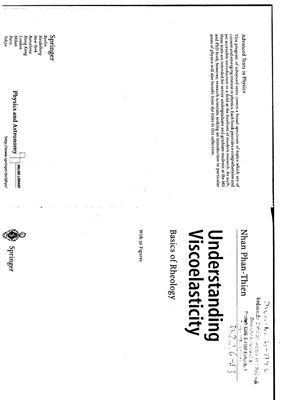Springer, 2002, Pages: 145, ISBN: 3540433953
Viscoelasticity (or rheology) is a highly mathematical subject, interfacing several disciplines, from applied mathematics to mechanics and engineering. Other books on rheology are usually comprehensive to such a degree that students find it hard to isolate the important physical principles and develop good analytical skills for solving useful engineering problems.
In this book, the necessary background for understanding viscoelasticity is covered; both the continuum and microstructure approaches to modelling viscoelastic materials are discussed, since neither approach alone is sufficient. The book starts with tensor notation, to give students the basic working tools, then addresses kinematics and constitutive equations, and ends with the constitutive modelling of polymer solutions and suspensions. It also includes a series of problems of graded difficulty. It is self-contained and ideally suited for a one-semester course on viscoelasticity.
Viscoelasticity (or rheology) is a highly mathematical subject, interfacing several disciplines, from applied mathematics to mechanics and engineering. Other books on rheology are usually comprehensive to such a degree that students find it hard to isolate the important physical principles and develop good analytical skills for solving useful engineering problems.
In this book, the necessary background for understanding viscoelasticity is covered; both the continuum and microstructure approaches to modelling viscoelastic materials are discussed, since neither approach alone is sufficient. The book starts with tensor notation, to give students the basic working tools, then addresses kinematics and constitutive equations, and ends with the constitutive modelling of polymer solutions and suspensions. It also includes a series of problems of graded difficulty. It is self-contained and ideally suited for a one-semester course on viscoelasticity.

